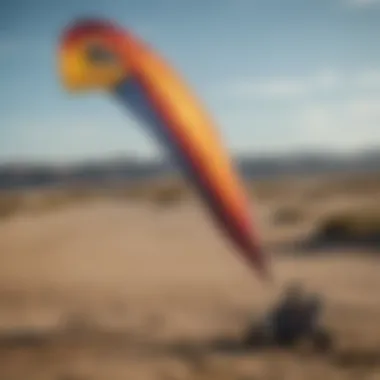A Detailed Look at the B2 Trainer Kite for Beginners


Intro
Kiteboarding, a sport that dances on the edges of thrill and serenity, often beckons those with an adventurous spirit. Among the essentials for beginners, the B2 trainer kite stands out. This kite serves not only as a fantastic introduction to the sport but also as a reliable partner through initial learning phases. As we journey through this comprehensive guide, it is crucial to grasp the intricacies of the B2 kite, its features, and the practical advice that ensures a safe and enjoyable experience.
In this guide, we will closely examine the construction of the B2 trainer kite and explore its performance metrics. Additionally, we dive into the selection of the right gear, blending safety with effective learning techniques. By the end, you'll be equipped with the insights needed for a smoother transition from ground training to the exhilarating world of kiteboarding.
Prolusion to B2 Trainer Kites
When one takes the plunge into the world of kiteboarding, the tools of the trade matter immensely. Among these tools, the B2 trainer kite stands out as a beginner's best friend. This section will provide insight into its significance and the nuanced understanding every novice should have when approaching this fascinating sport. In contrast to other kites, trainer kites play a critical role in mastering the foundational skills needed for maneuvering on the water. The B2 model, with its specific design features and benefits, is ideal for newcomers.
Purpose and Benefits
The primary purpose of the B2 trainer kite is to facilitate an easy entry into kiteboarding. Unlike larger kites that can overpower a learner, the B2 offers a manageable size and weight, promoting safety while users hone their skills. Key benefits include:
- Skill Development: The B2 kite allows beginners to practice essential actions such as controlling, launching, and landing the kite. It paves the way toward proficiency in kite handling.
- Safety: Due to its design, the B2 kite provides a low-to-the-ground option that minimizes the risk of accidents, allowing fledgling kiteboarders to learn without undue stress.
- Versatility: This particular model is adaptable to various wind conditions, making it suitable for different environments as users progress.
Overall, the B2 trainer kite is a stepping stone that emphasizes gradual learning, ensuring that novices gain confidence before transitioning to larger, more complex kites.
Target Audience for B2 Trainer Kites
Identifying the target audience for the B2 trainer kite is essential for understanding who can benefit the most from its design and features. The B2 is crafted mainly for:
- Newcomers: Those who have never flown a kite before or are just dipping their toes into the kiteboarding scene. The simplicity of operation attracts individuals eager to learn the ropes.
- Instructors: Surf schools and experienced kiteboarding coaches utilize this model to introduce students to the basics. The kite's forgiving nature allows instructors to safely teach necessary skills.
- Parents with Kids: When it comes to family outings, the B2 offers a safe and manageable option for young adventurers, making it easy for kids to learn under supervision.
Understanding the needs of these groups helps reinforce why the B2 trainer kite is designed with user-friendliness in mind. It acts as an entry point not just for young thrill-seekers but also for adults embracing the kiteboarding culture. The B2, therefore, bridges the gap between curiosity and competence in this exhilarating sport.
Understanding the Design Elements
When delving into the realm of B2 trainer kites, understanding the design elements becomes a key piece of the puzzle. Each element, from the materials used to the kite's shape and bridle systems, plays a crucial role in determining how the kite performs in the air. By grasping these design nuances, beginners not only gain insight into how to select the right equipment but also improve their flying techniques and overall kite experience.
Material Selection
Choosing the right materials for a trainer kite is vital. The kite's construction materials directly influence its weight, durability, and performance in various wind conditions. Generally, two types of materials are commonly used for the fabric: nylon and polyester.
- Nylon: It tends to be lighter and offers better resistance against tearing, making it a popular choice. However, it might not hold up as long under prolonged exposure to UV rays without proper treatment.
- Polyester: This is more robust against weather elements, especially the sun. It usually provides less stretch compared to nylon, which can be beneficial for maintaining shape during flight.
In addition to the fabric, the frame materials such as fiberglass or carbon fiber are also worth considering. Carbon fiber offers excellent strength-to-weight ratio but comes with a steep price tag. When making choices about gear, weighing these materials against your personal goals and expected flying conditions is prudent.
Wing Shape and Size
The wing shape and size of a B2 trainer kite are significant factors that can influence how the kite behaves in the air. Generally, a larger wing area allows for more lift and stability, which is crucial for beginners.
- Size Considerations: A kite that is too large can be overwhelming and difficult to control, while a kite that is too small may not provide enough lift in lighter winds. A common recommendation for beginners is to choose a size that matches their weight. For instance, a smaller individual might prefer a 1.5-meter kite, while someone heavier might need a 2.5-meter model.
- Shape Factors: The shape of the kite, whether it’s delta, flat, or curved, impacts how it interacts with the wind. A delta-shaped kite usually offers stability in gusty conditions. In contrast, flat kites can be more efficient for speed.
By paying close attention to the pretty angularities of the design, novice flyers can develop a clear understanding of what suits them best as they progress.
Bridling Systems
Bridling systems are the unsung heroes of kite design. They may not always be visible at a glance, but they are integral in controlling how the kite reacts to wind forces and how it maintains structural integrity.
There are several types of bridle configurations:
- Two-line systems: This is often recommended for beginners. It simplifies control and ensures the kite’s response is straightforward–pull one line to go up and the other to descend.
- Four-line systems: Although these offer more precision and maneuverability, they can be tricky for those just starting out.
Understanding the bridle system aids in adjusting the kite for different wind conditions and helps to optimize power when flying. A functional bridle optimally distributes tension across the kite, contributing to enhanced stability and performance.
"The subtle differences in design can transform a simple flying session into a remarkable learning experience."
Overall, the thoughtful integration of material selection, wing shape, and bridle systems significantly contributes to the B2 trainer kite's effectiveness, enabling newcomers to grasp the basics of ease and control. Through a blend of awareness and practice, beginners can elevate their kiteboarding skills and enjoyment.
Advantages of B2 Trainer Kites
The B2 trainer kite stands out as a fantastic entry point for anyone venturing into kiteboarding. From the technicalities of kite mechanics to the ease it offers to beginners, understanding its advantages is crucial for prospective kiteboarders. In this section, we delve into the specific elements that make these kites so appealing, highlighting how they cater to the needs of new enthusiasts while enhancing their overall experience.


Ease of Control
One of the most significant benefits of the B2 trainer kite is its remarkably user-friendly control system. For a novice, there’s nothing worse than feeling like you’re battling your gear rather than enjoying the experience. The B2's design allows beginners to grasp the nuances of handling a kite with immediate feedback. The lightness of the materials used means that even a gentle tug on the lines translates into a responsive movement of the kite in the sky.
- Responsive Steering: The B2 provides sharp response times, letting new users have a feel for how kites behave in the wind.
- Simplified Control Bar: The control bar is designed to minimize confusion, facilitating smoother maneuvers without overwhelming a learner.
Ultimately, this ease of control cultivates a sense of confidence. As beginners familiarize themselves with the basic principles of kite flying, they can focus more on enjoyment rather than tackling complex controls. This confidence can go a long way in transitioning from land to water.
Stability in Flight
Another compelling advantage of the B2 trainer kite is its impressive stability, which is essential for anyone just starting out. The kite’s design is tailored to maintain a steady flight pattern, even in fluctuating wind conditions. This stability means that beginners spend less time worrying about erratic movements and can focus on refining their skills.
"A steady kite is like a friendly guide; it teaches without terror."
- Broader Wind Range: The B2 trainer kite is engineered to perform reliably across a wide array of wind conditions, allowing users to engage with their sport more frequently.
- Reduced Risk of Crashing: New flyers often panic when they sense a kite descending quickly, but the B2's design minimizes sudden drops, greatly lowering the chances of crashing, which can be discouraging for learners.
This steadiness not only aids training but also boosts the overall learning experience, allowing users to enjoy their time outside with peace of mind.
Enhanced Learning Experience
A major goal of the B2 trainer kite is to provide an enriching learning experience for newcomers. Unlike some complex models that may hinder those just starting out, the B2 is constructed to facilitate gradual skill development.
- Progressive Skill Building: With the B2, users can start with foundational skills like basic flying and gradually progress to managing speed and tricks.
- Supportive Community: The popularity of the B2 in the kiteboarding community means there are ample resources—tutorials, forums, and instructional videos—at hand to help users advance their skills.
Furthermore, using the B2 for training promotes a sociable aspect too. Learning with friends or being part of a local group can make all the difference. Sharing experiences and tips can help maintain motivation while also keeping the training fun.
In summary, the advantages of B2 trainer kites meld seamlessly with the goals of beginners looking to enter the exhilarating world of kiteboarding. With ease of control, considerable stability, and a focus on enhancing the learning experience, it’s no wonder that the B2 kite has become a favorite among newcomers.
Preparing for Your First Flight
Preparing for your first flight with the B2 trainer kite is a crucial part of your kiteboarding journey. This phase marks the transition from theory to practice, where you can finally experience the thrill of flying your kite. Careful preparation not only enhances your safety but also boosts your confidence, setting a solid foundation for mastering kite control and techniques.
Setting Up the Kite
Setting up the kite properly is the first step toward a successful flight. Here’s a simple rundown of how to do it:
- Find a Stable Surface: Choose a flat and open area, ideally with little to no obstacles like trees or power lines. This helps to avoid any unexpected surprises during your flight.
- Unpack and Inspect: Carefully take out the kite from its bag, avoiding any sharp objects that could damage it. Inspect it for any tears or defects before you begin.
- Lay the Kite Flat: Spread the kite on the ground in its entirety. This allows you to check the lines and ensure they are untangled.
- Connect Lines to the Kite: Attach the flying lines to the correct points on the kite. Each line should be secured properly; failure to connect the lines correctly can lead to poor performance in the air.
- Arrange Control Bar: Place the control bar in front of you, ensuring that the lines are free and organized so they don’t get tangled during your first launch.
Setting your kite correctly helps in achieving a more enjoyable first flight experience, minimizing the chance of getting caught up in confusion just when you are about to take off.
Safety Precautions
Safety is paramount when venturing into kiteboarding, especially when you are still learning. Here are some essential safety precautions to take into account:
- Wear Protective Gear: A helmet and impact vest can protect you from falls or collisions.
- Check Wind Conditions: Before you begin, make sure to assess the wind strength and direction. A steady wind is best for beginners. Avoid flying in strong or gusty winds.
- Practice with a Partner: If possible, have an experienced friend around. They can offer guidance, help you set up or even assist in case anything goes wrong.
- Know Emergency Protocols: Familiarize yourself with the emergency release system on your kite and practice how to use it. This knowledge can be crucial in a pinch.
- Stay Alert: Always keep an eye on the surroundings. Be wary of people, objects, or sudden changes in wind.
"A little preparation goes a long way. Always prioritize safety—better safe than sorry."
Choosing the Right Location
Selecting the right location to fly your B2 trainer kite can drastically affect your learning experience. Here are some pointers to consider:
- Open Areas: Look for spacious and clear areas, like beaches or dedicated kite flying zones. These places offer a safer environment to practice.
- Avoid Crowded Spots: While it might be tempting to fly in popular places, avoid them until you are more confident in your skills. Crowds pose risks, not only for you but also for bystanders.
- Wind Factors: Choosing a location with steady and consistent winds is vital. If the wind is too light, your kite won’t perform well; if it’s too strong, it can become uncontrollable, defeating the purpose of practice.
- Access to Help: Consider locations where help is readily available. Beaches with kiteboarding schools, for instance, are perfect as instructors are always nearby.
Techniques for Effective Training
Understanding the various techniques for effective training with the B2 trainer kite holds paramount importance, especially for those just dipping their toes into the kiteboarding waters. Mastery of foundational skills often paves the way for a successful transition into more advanced maneuvers and ultimately, thrilling water sports. Starting off on the right foot—or in this case, the right kite attitude—sets the stage for a rewarding experience.
Basic Flying Techniques
When it comes to learning how to fly the B2 trainer kite, getting a good grasp on the basic flying techniques can feel like laying the first bricks of a solid foundation. The initial flying experience introduces novice kiteboarders to how the kite interacts with the wind. The key components include the point of control and the body’s orientation in relation to the kite’s positioning.
- Understanding the Control Bar: The control bar affixes the kite to the user, and it’s through this tool that a beginner learns to steer and manage the kite's ascent and descent. Holding it firmly but relaxed is essential.
- Launching and Landing: The best way to initiate flight is by aligning the kite at a 45-degree angle relative to the wind. For safe landings, lowering the kite gently to a position at the edge of the wind window can help avoid surprises. It’s crucial to practice launching and landing multiple times to build muscle memory.
- Using Your Body: Once the kite is in the air, it’s all about positioning. Leaning towards where you want the kite to go will help in steering. Beginners should always keep an eye on the kite to avoid losing control, especially during gusty winds.
Controlling Power and Speed


Learning how to control power and speed during kite flying is a game changer. This knowledge ensures safety while maximizing the kite’s performance. By properly modulating how much power the kite generates based on its angle relative to the wind, beginners can avoid overwhelming sensations.
- Power Zones: Kiteboarders should become familiar with the concept of power zones. The area directly in front where the wind hits the kite creates the most power. Conversely, flying the kite high above the head can decrease power, making it easier to handle.
- Smooth Handling: Smooth movements of the control bar—pushing down to generate power and pulling up to depower—are essential for maintaining control. Jerky motions can lead to sudden surges in speed or loss of control. Constantly practicing transitions between powered and depowered situations can enhance flying proficiency.
- Wind Awareness: Understanding how wind changes strength or direction during the flight is vital. Keeping an eye on observations, such as flags or nearby kiters, can offer insight into adjusting accordingly.
Trimming the Kite
Kite trimming may initially seem like a tedious task, but it plays a significant role in achieving optimal performance and comfort. Being aware of how to trim the kite involves adjusting the lines, affecting how the kite behaves in wind conditions.
- Line Lengths: The length of the front lines versus the back lines can make a difference in how the kite flies. Shortening the back lines may make the kite more responsive, while longer back lines lead to increased stability during flight.
- Fine-Tuning Performance: Kite trimming is especially useful in gusty conditions. Beginners should experiment with trimming their kites to see how small adjustments can make a big difference in handling and predictability.
- Feedback Loop: After making adjustments, attempts to fly the kite in varying conditions will provide valuable feedback. Each flight helps refine the user's skills and fosters a deeper understanding of the kite's behavior.
Mastering techniques and understanding the dynamics behind them will elevate your kiteboarding experience, making each outing safer and even more enjoyable.
By investing time in developing these skills and techniques, novice pilots can indeed empower themselves��—not just to fly their kites, but to harness the winds, dancing gracefully above the waves. With each practice session, the feel of the kite will become second nature, transforming the initial hops into sweeping arcs across the sky.
Common Mistakes and How to Avoid Them
When it comes to flying the B2 trainer kite, beginners often trip up in a few key areas. Recognizing these common pitfalls can not only save a lot of frustration but also enhance the overall learning experience. By addressing specific mistakes early on, you’ll find that flying becomes smoother and more enjoyable, laying a solid foundation for kiteboarding gains in the future.
Misjudging Wind Conditions
One of the most pivotal aspects of kite flying is gauging wind conditions. Newcomers often mistake light breezes for suitable kite-flying weather, which can lead to a less than ideal experience. For instance, when the wind is too weak, the kite may luff and become unresponsive. Conversely, strong winds can over-pull the kite, leading to loss of control or even crashing.
To avoid falling into the trap of misjudging the wind, try the following:
- Always check the wind meter. Indicators like an anemometer or weather app can provide real-time data about the wind speed.
- Observe the environment. Look at trees, flags, or other kites. If they're barely moving, it’s likely too calm; if they’re whipping about, better opt for a lighter kite.
- Feel the wind on your skin. This may sound basic, but personal experience can often tell you more than gadgets.
"Understanding wind conditions is like having a compass; it guides your kite-flying journey."
Incorrect Flying Techniques
Flying techniques may seem trivial, but let one simple error slip, and it can take your flying from picturesque to pandemonium in seconds. Many beginners lean too heavily on their arms rather than using their whole body to maintain balance and control. This not only exhausts you faster but can lead to poor kite handling and, ultimately, crashes.
Here are some tips to ensure your techniques are on point:
- Use your body. Instead of just pulling on the bar, engage your core and legs to control the kite's direction and speed. Maintain a relaxed stance to absorb any jarring movements.
- Practice smooth movements. Jerky actions can destabilize the kite. Fluid, deliberate motions help maintain stability.
- Focus on the trim. A well-trimmed kite responds better to input, allowing you to experience the kite's potential fully.
In summary, honing your skills involves understanding not just how to fly, but how conditions affect your experience. Mistakes made when misjudging wind conditions or applying incorrect techniques can tarnish your perception of the sport, often deterring future attempts. With insight into these common errors and strategies to avoid them, you'll be well on your way to enjoying your B2 trainer kite to its fullest.
Gear Maintenance and Care
Taking care of your gear isn’t just a matter of keeping things neat and tidy; it’s a fundamental aspect of engaging with the B2 trainer kite that can significantly impact its longevity and performance. Imagine investing time and resources into training, only to have your equipment falter due to neglect. Understanding the specifics of maintenance brings long-lasting benefits, helping to avoid premature wear and tear and ensuring that your kite remains in prime condition for the next training session. Proper maintenance can also enhance your level of safety when flying, making it an area that deserves careful attention.
Cleaning Your Kite
When it comes to maintenance, cleaning stands at the forefront. After spending a day battling the elements, it’s easy to overlook how dirt, salt, and sand can accumulate on your kite's fabric and fittings. This buildup may appear inconsequential, but over time it can lead to deterioration or even functional problems.
Start by rinsing your kite with fresh water. This clears away salt or sand which, if left unattended, can degrade the material or interfere with the kite’s aerodynamic properties. It’s recommendable to use mild soap with a soft cloth for those stubborn marks. Simply scrub gently; aggressive cleaning can cause more harm than good.
- Rinse with Fresh Water: This is vital after a session in salty or sandy conditions.
- Use Mild Soap: For deeper stains, a mild soap can work wonders but avoid harsh chemicals.
- Dry Thoroughly: Make sure your kite is completely dry before packing it away to prevent mold or mildew.
"A little cleaning goes a long way. Make it a routine to keep your kite happy and performing well."
It is a good habit to check for any damage while cleaning. Look for frays on the fabric or issues with the bridles. By staying proactive, you might catch small problems before they have a chance to escalate.
Storing Your Equipment
Storage is another critical side of gear maintenance. If you think tossing your kite into a bag and calling it a day is enough, think again. Proper storage not only helps maintain the kite’s shape but also protects it from the elements, preventing wear.
First off, ensure that your kite is entirely dry before storing it. A damp kite is an open invitation for mold, which can ruin your gear. Roll your kite neatly and loosely, rather than folding it tightly. This prevents creases that could affect its flight characteristics.
Some points to keep in mind when storing your equipment:
- Keep It Cool: Store in a cool, dry place. Heat can warp materials.
- Avoid Sunlight: Direct sunlight can degrade the fabric over time; consider a dark storage area.
- Use a Protective Bag: Invest in a good-quality gear bag that offers protection against physical damage.
Comparing B2 Trainer Kites with Other Models


In the ever-growing world of kiteboarding, making the right choice of gear can mean the difference between a thrilling experience and a frustrating one. When it comes to starter kites, B2 trainer kites have garnered attention for their unique characteristics and performance. However, comparing them with other models in the market is essential for new enthusiasts to grasp their true value. Understanding these comparisons not only informs one’s buying decision but also enhances the learning curve.
Features of Competitor Models
While the B2 trainer kite offers a solid grounding for beginners, it's wise to look at what else is out there. Many competitors present unique features that may cater better to certain preferences or conditions. Here are some key aspects to consider:
- Material Quality: Competitor kites might use different fabric technologies, which can affect durability and responsiveness. Some brands focus on a lighter fabric for agility, while others might prioritize sturdiness to withstand harsher conditions.
- Adjustable Settings: A few models allow more customization when it comes to bridles, giving users the advantage of tuning their kite's performance to their liking. This could be a major plus for someone wishing to grow rapidly in skills.
- Portability: Many newer models have been designed for ease of travel, with compact packing and lightweight materials. This can greatly benefit those who often transport their gear.
- Establishment: Some brands have decades of experience in the industry, and their products boast refinements that come with time. In contrast, newer entrants may still be ironing out the kinks in their designs.
These differences may seem subtle at first glance, yet they can substantially influence your flying experience.
Cost Considerations
When weighing options, cost plays a crucial role. Price differences between the B2 trainer kite and its competitors can be substantial, so understanding what your investment yields is important. A few points to consider include:
- Initial Investment vs. Long-Term Use: The B2 model may be less expensive, but it’s worth asking how long you can expect the kite to last. Cheaper kites can tend to wear out faster if not constructed properly.
- Value of Features: Sometimes, a higher price tag comes with features that can be invaluable for growth as a kiteboarder. This includes additional training resources or expert backing, which can enhance your learning experience.
- Resale Value: Some brands retain their resale value better than others. This is crucial if you're considering upgrading your gear down the line.
Ultimately, while the B2 trainer kite has plenty to offer, newcomers should weigh all these factors carefully in their quest for the ideal trainer kite.
"Choosing the right trainer kite sets the stage for your journey into kiteboarding. Take the time to compare and learn; it’ll pay off down the line."
By assessing these elements thoughtfully, kiteboarders—whether adventurous amateurs or traveling instructors—can make more informed decisions that will serve them not just for the first flight but for many sessions to come.
Community Experiences and Reviews
Understanding the community's experiences with the B2 trainer kite is invaluable for both newcomers and seasoned kiteboarders. These insights provide a firsthand look at the kite's real-world performance, offering potential users a well-rounded perspective that goes beyond spec sheets and marketing claims. When individuals in the kiteboarding community share their stories and opinions, it paints a clearer picture of what to expect, helps to identify both the advantages and drawbacks, and informs better purchasing decisions.
The collective knowledge from these shared experiences also fosters a sense of belonging among kite enthusiasts, reinforcing the idea that one does not embark on this adventure alone. Relying on community feedback can make the difference between a positive introduction to kiteboarding and a frustrating one, particularly for those just getting their feet wet in this exhilarating sport.
User Testimonials
User testimonials offer a deep dive into the day-to-day interactions individuals have with their B2 trainer kites. These personal stories often reveal the kite's ease of use, durability, and overall performance under various kiteboarding conditions. For example, one user from Instagram describes how, during his first experience with the B2, he was surprised at how intuitive the controls felt, making it easy to learn the basics without overwhelming complexity.
Another testimonial shares how the kite’s stability in the air gave a first-time user the confidence to attempt maneuvers they might have shied away from with lesser kites. Here are a few elements highlighted in testimonials:
- Durability: Users frequently mention how well the materials hold up against tough conditions.
- Versatility: Many have noted how the B2 can adapt to various wind conditions.
- Comfort: The user-friendly design often translates to a stress-free flying experience, even for those who might not consider themselves athletic.
These testimonials serve not only as encouragement to those on the fence about starting kiteboarding but also as practical insights that can mitigate some of the challenges beginners face.
Expert Opinions
Expert opinions lend a layer of credibility to the discourse surrounding the B2 trainer kite. Professionals who have spent years in the field can provide detailed analyses of how the B2 compares to competitors or analyze its construction and performance nuances in depth.
A renowned kiteboarding instructor noted that the B2 trainer kite is "a superb entry point for beginners," citing its forgiving nature and stable handling characteristics which can truly make a difference when learning the fundamentals. Another industry expert claimed that the kite’s build quality significantly reduces the likelihood of experiencing failures mid-flight, a common concern for newcomers who might be unsure of their skills.
When weighing benefits based on expert feedback, several recurring themes emerge:
- Safety Features: Experts emphasize the inclusion of safety systems that protect users in case of unexpected situations.
- User-Focused Design: Many notes highlight why intuitively designed kites can dramatically improve the learning experience for novices.
- Community Engagement: Experts recommend participating in local kiteboarding communities or clubs for support, which echo the same sentiments shared by user testimonials.
In sum, while individual experiences can vary, the overarching feedback from both users and experts suggests that the B2 trainer kite represents an excellent option for anyone looking to leap into kiteboarding. When combined, these real-world insights can help process the information presented, guiding newcomers as they navigate their choices and embark on this thrilling outdoor pursuit.
Epilogue
The conclusion serves as the light at the end of the tunnel, encapsulating all the crucial insights shared throughout this guide about the B2 trainer kite. Summing up the information not only reinforces the learning journey but also cements the significance of this knowledge for beginners stepping into the realm of kiteboarding.
Final Thoughts on B2 Trainer Kites
In reviewing the multifaceted dimensions of B2 trainer kites, it's clear these kites offer a gateway into an exhilarating sport. They have been designed with newcomers in mind, integrating safety, ease of use, and a learning curve that's just right for those eager to fly.
With solid construction and performance characteristics, the B2 trainer kite ensures stability, whether on land or in the water. New users can focus on mastering control without the added burden of complex features found in more advanced models. This simplicity is not just enjoyable, but crucial in fostering confidence.
Additionally, the potential for mistakes is always lurking, especially with varying wind conditions. But the guide emphasizes techniques tailored for beginners, mitigating common pitfalls like misjudging the forces at play in the air.
Here are a few key takeaways about the B2 trainer kite:
- Designed for beginners: The features simplify flying while ensuring safety.
- Performance-driven: Aimed at enhancing user experience, balancing power and control.
- Focus on preparation: Proper setup and safety measures are paramount.
"The right foundation in training kites lays the groundwork for a fun and safe kiteboarding future."
Ultimately, the journey with the B2 trainer kite leads beyond merely learning to fly; it's about embracing a lifestyle filled with adventure and camaraderie within the kiteboarding community. Whether as a hobbyist or an adventurer, you will find that with a B2 trainer kite, every gust of wind opens up new possibilities.
As you move forward, equipped with knowledge from this guide, remember, practice is essential. The real magic happens when you take that first leap into the sky. Happy flying!















